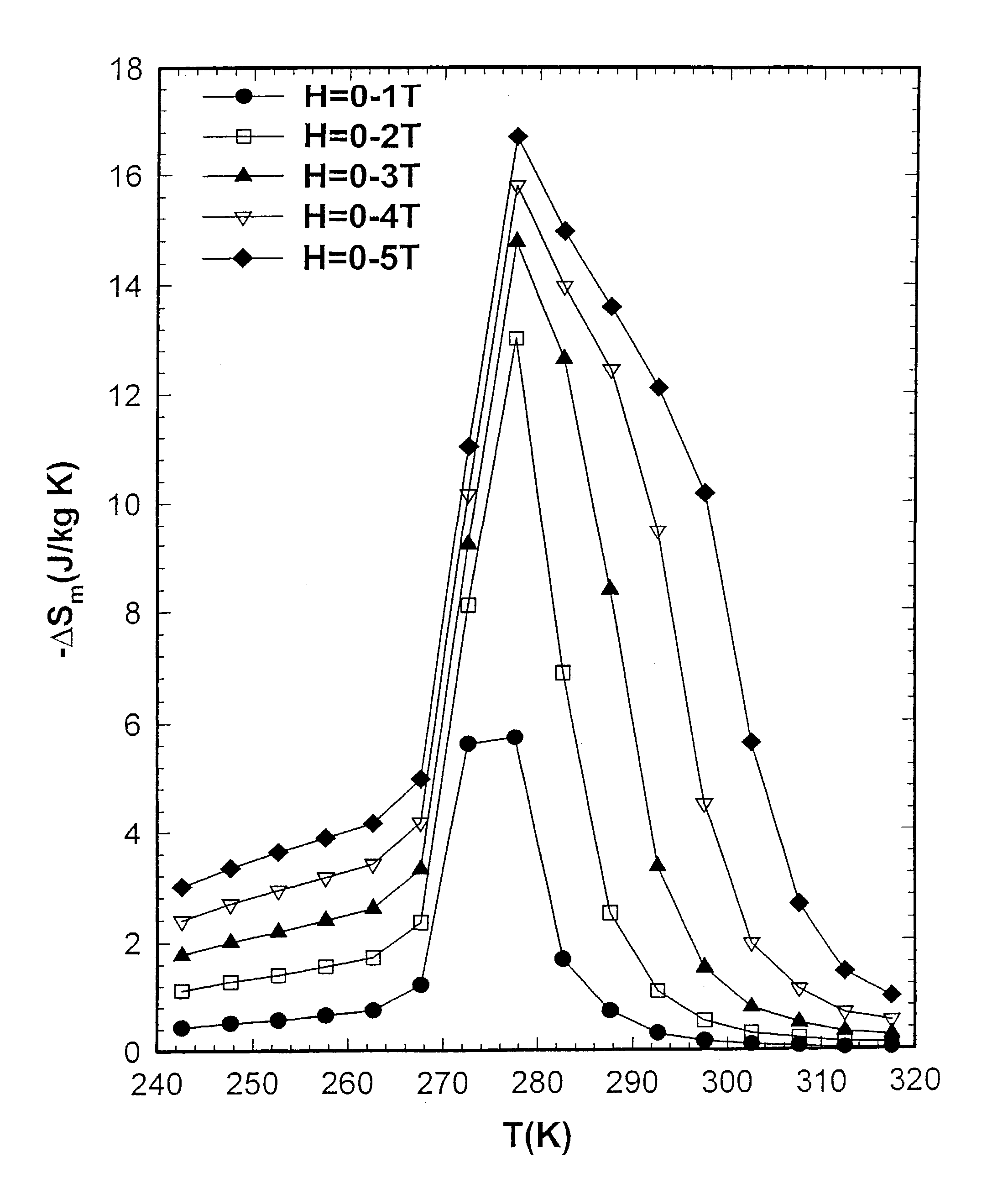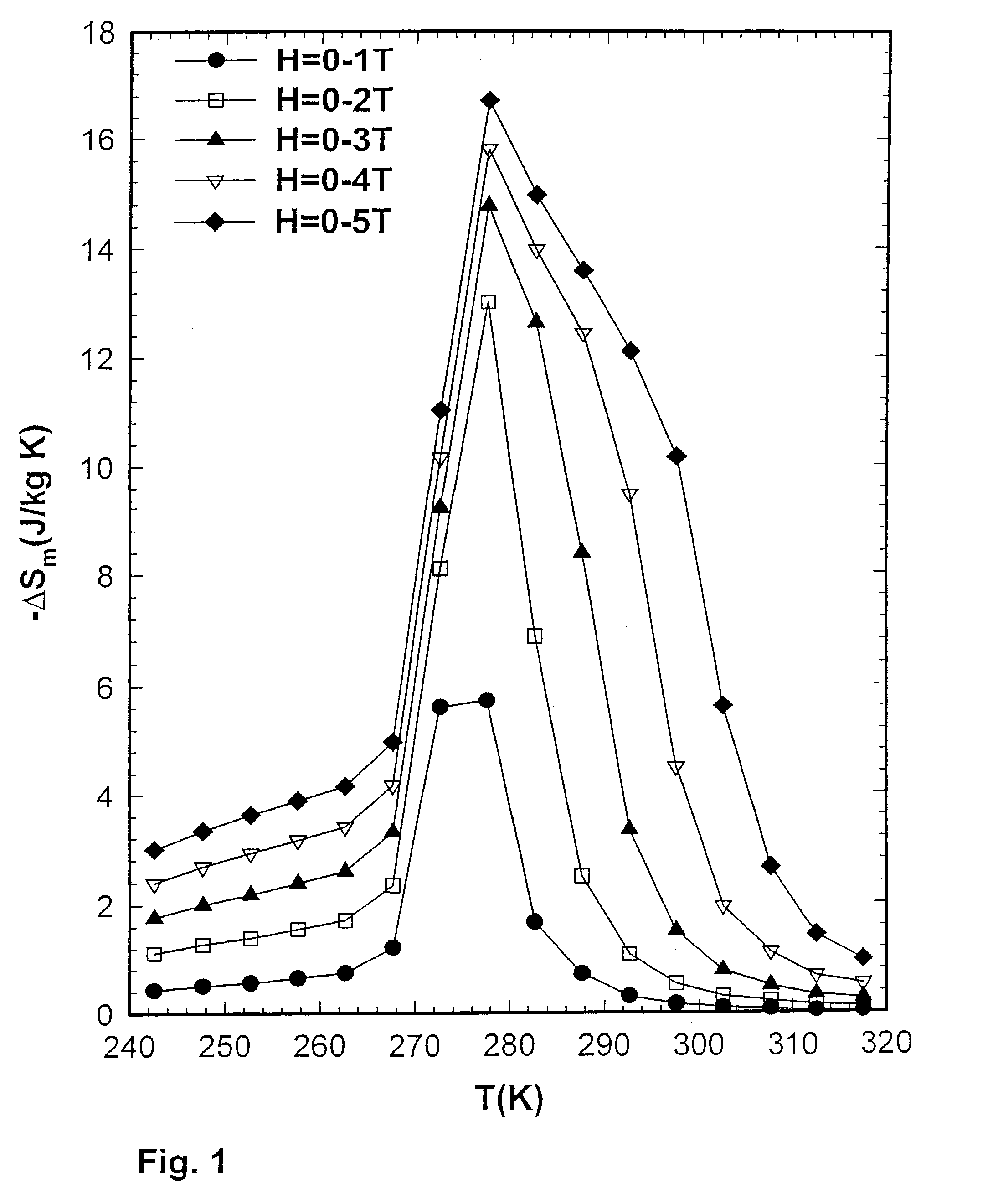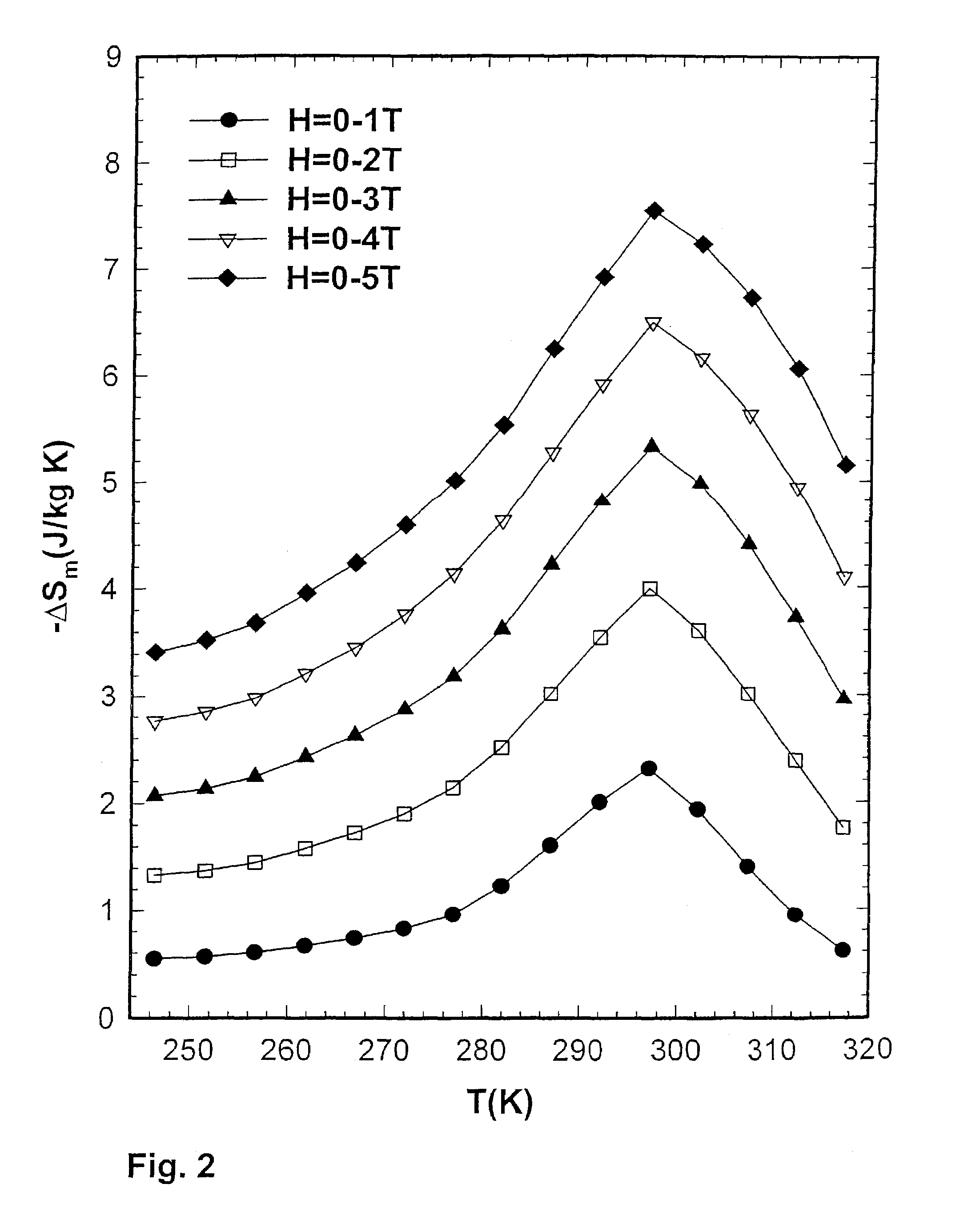[0057]The inventors compared the magnetocaloric effect (MCE) properties of Gd5(Si2Ge2) prepared by the reaction of the induction melted three alloy components in a Ta crucible with those of an arc-melted button sample. The inventors found that −ΔSm (MCE) value of the sample prepared in the Ta crucible was 17 J / kg K (FIG. 1) compared to 7 J / kg K (FIG. 2) for the arc-melted sample. Both samples were prepared from the same commercial Gd stock, which had a carbon impurity content of 327 wt. ppm (0.43 at. %) and an oxygen impurity content of 0.186 wt. % (1.85 at. %), where wt. ppm means parts per million by weight. The induction melted sample was prepared by heating Gd, Si, and Ge to a temperature of 1800° C. in vacuum, holding for about 60 minutes before cooling directly to room temperature without an intermediate anneal. The arc-melted sample was prepared by melting Gd, Si, and Ge under 1 atmosphere of He in an electrically generated arc on a water cooled Cu hearth, and was remelted six times, turning over the metal button between melts to insure homogeneity. The former value is about the same as reported in inventors' original paper announcing the discovery of the giant magnetocaloric materials3 (the Gd used in that study3 was obtained from the Ames Laboratory, Materials Preparation Center, Ames, Iowa, and had significantly lower C and O impurity contents, such lower C, O material being referred to herein as AL material). An exemplary Gd material available from Ames Laboratory typically exhibits a C impurity of about 236 ppm atomic, N impurity of about 11 ppm atomic, O impurity of about 472 ppm atomic, and F impurity of less than about 25 ppm atomic.
[0058]In contrast, commercially pure Gd generally comprises at least about 90 atomic % Gd, about 0.03 to about 1 atomic % C impurity, about 0.10 to about 4 atomic % O impurity, about 0.01 to about 1 atomic % N impurity, and about 0.001 to about 1 atomic % all other impurities, where other impurities include Cl, F, Na, Mg, Al, Si, Ca, Ti, Fe, Ni, Y, and Ta. A typical range of impurities in commercially pure Gd are 900–2,950 ppm atomic C, 270–460 ppm atomic N, 12,800–26,500 ppm atomic O, and 4–2,090 ppm atomic F.
[0059]It would appear that the C and O impurities in the molten Gd5(Si2Ge2) alloy, which is held for 1 hour at 1800 degrees C. at ˜10−6 torr, react to form CO or CO2 which are pumped-off in the dynamic vacuum of ˜10−6 torr. The C and O reaction appears unlikely to occur in the molten arc-melted button, since the time is so short (a few minutes) and since arc-melting is carried out in a helium (or argon) atmosphere very little C and O impurities are removed during the arc-melting process. Experiments were conducted to evaluate the detrimental effect of carbon impurity on the giant MCE as indicated from a study of the effect of alloying additions.4 For example, three samples, which were prepared by melting in Ta crucibles with different covers over the crucible, were heated together simultaneously in the induction furnace and held in the molten state for 15 minutes at 1800 degrees C. at 10−6 torr. The three cover arrangements were as follows: (1) a flat piece of Ta covering the entire opening of the crucible, FIG. 3A; (2) an inverted, slightly larger crucible covering the opening, FIG. 3B; and (3) a welded-shut crucible, FIG. 3C. After the melting operation the samples were cooled down and it was noted that the welded-shut crucible was bowed outward, indicating that a gas pressure had built up inside the crucible during the heating operation. The magnetization measurements of the three Gd5(Si2Ge2) samples made in these crucibles gave maximum −ΔSm values of 12 to 13 J / kg K and two peaks (magnetic ordering temperatures) of 277 and 287 K for the first cover arrangement (FIG. 4); −ΔSm=13 and 5 J / Kg K at 257 and 297 K, respectively for the inverted crucible arrangement (FIG. 5); and a −ΔSm=8 J / kg K and a single peak at 278 K for the sealed crucible (FIG. 6). These −ΔSm values indicate that the C impurity remained in the Gd5(Si2Ge2) alloy which was melted in the welded-shut Ta crucible, and that −ΔSm was essentially the same as for the arc-melted button (see above). Chemical analysis of the arc-melted button indicate that this sample contained 318 wt. ppm (0.42 at. %) C impurity, which is essentially the same as that of the commercial starting Gd metal [327 wt. ppm (0.43 at. %) C]. Furthermore, the C impurity content of a Gd5(Si2Ge2) sample held molten at 1800 degrees C. for 1 hour in a Ta crucible at 10−6 torr with a loose-fitting lid was 109 wt. ppm (0.14 at. %), and its maximum −ΔSm value was 18 J / kg K (FIG. 7). Additional confirmation was obtained from another Gd5(Si2Ge2) sample melted in a Ta crucible with a flat lid, FIG. 3A at 1800 degrees C. for 1 hour and heat treated at 1600 degrees C. for one hour after rapid solidification, which was obtained by shutting of the power to the induction furnace. The maximum −ΔSm value and magnetic ordering temperature was 28 J / kg K and 267 K, respectively (FIG. 8). Furthermore, a comparison of the chemical analyses of the Gd starting material and the last-made Gd5(Si2Ge2) alloy, see Table 1, shows that there is a reduction in both C and O impurities, by 0.26 and 0.41 at. %, respectively. This suggests that the C impurity is lost as a mixture of CO (>55%) and CO2 (<45%), assuming that the reduction of the amount of O impurity is due entirely to the C oxidation process.
[0060]TABLE 1Chemical Analysis Of The Commercial Gadolinium Starting Materialand of a Melted in Ta Crucible, Rapidly Quenched, Heat TreatedGd5(Si2Ge2) Sample (All Values Reported in Atomic Percent)ImpurityGadoliniumGd5(Si2Ge2)C0.430.17N0.430.28O1.831.42F0.370.17
[0061]The MCE data determined from magnetization measurements for most of the Gd5(Si2Ge2) alloys prepared by reacting the alloy components in a Ta crucible exhibited a double peak structure in the −ΔSm vs. T plots (FIGS. 4 and 5). The samples were melted in the Ta crucible with flat lid, FIG. 3A and with an inverted crucible lid, FIG. 3B at 1800 degrees C. for 15 minutes at 10−6 torr, then the induction furnace power was turned down slowly until the temperature reached 1700 degrees C. (˜50 degrees C. below the melting point of the alloy) in 15–30 minutes and held there for 15 minutes. This process was continued in the same manner holding at 1650 degrees C. for 15 minutes and finally for 30 minutes at 1600 degrees C. before turning off the power.
[0062]After obtaining these results one of the Gd5(Si2Ge2) samples was remelted at 1800 degrees C. under vacuum of 10−6 torr and cooled in the same manner as noted in the above paragraph. But since some of the sample did not melt, it was again reheated at 1870 degrees C. for 15 minutes, then cooled to 1750, 1700, and 1650 degrees C. holding for 15 minutes before a final anneal at 1600 degrees C. for 30 minutes. This alloy was then sampled at the top and bottom portions of the ingot. The MCE values were −ΔSm=19 J / kg K and Tc=272 K for a sample taken from the top of the ingot, and −ΔSm=14 J / kg K and Tc=287 K from the bottom of the ingot sample. The difference in the −ΔSm values (and the different Tc values) from top to bottom suggested that phase segregation of the melt occurs on solidification because the Gd5(Si2Ge2) material does not melt congruently. Furthermore, the low −ΔSm and high Curie temperature for the bottom portion of the ingot suggests that a Si-rich Gd5(SixGe1−x)4 phase solidified first, and since the solid phase is expected to be more dense than the liquid phase it sinks to the bottom of the crucible. From published results5 alloys richer than x=0.5 would exhibit a normal MCE (i.e. −ΔSm<19 J / kg K) and have a Tc>275 K. The last to freeze liquid would be a Ge-rich alloy (x<0.5) which would exhibit the giant MCE (i.e. −ΔSm≧19 J / kg K) and have a Tc<275 K,5 which is what was observed.
 Login to View More
Login to View More 


